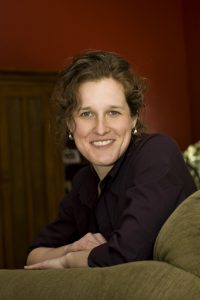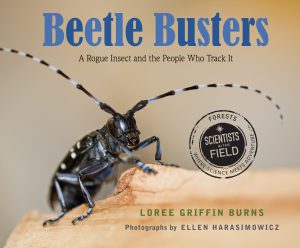By Rebecca LeBoeuf
 A writer of nonfiction science books for children and teenagers, Dr. Loree Griffin Burns covers topical issues such as ocean pollution as well as the natural world, including books about honey bees and the life cycle of butterflies. Her books have garnered many awards, including an IRA Children’s Book Award, a Green Earth Book Award and ALA Notable designations.
A writer of nonfiction science books for children and teenagers, Dr. Loree Griffin Burns covers topical issues such as ocean pollution as well as the natural world, including books about honey bees and the life cycle of butterflies. Her books have garnered many awards, including an IRA Children’s Book Award, a Green Earth Book Award and ALA Notable designations.
A popular speaker at schools, libraries, conferences, and more, you can learn more about Burns via her website.
Have you always written?
Yes. But it took me a long time to figure out what I wanted to write about. I wrote my first story in middle school: it was a mystery starring two girls—Julie and Leslie –who were actually thinly-disguised literary versions of me and my childhood BFF, Kelley (we were both Nancy Drew fans). And as a young adult, I wrote a lot of short fiction. I was a working scientist by then, but somehow it hadn’t occurred to me to write about my life’s work!
What’s your process in developing your storyline and characters?
I write nonfiction, so my storylines and characters come already developed. That said, one of my most important jobs, as author, is to choose how best to introduce readers to the scientists I’m writing about, and how best to share their stories with readers. While researching a book, my process is to gather as much information as possible. Some of this comes from reading other works on the topic, and some of it comes from first-hand experiences I have with my subjects: interviews, field trips during which I get to shadow them in the lab or in the field, email correspondence and so on. Later, when I’m drafting the book, I winnow this material down by asking myself a lot of important questions. Which information will help my reader understand the scientist and his motivations? Which highlight the important themes of the book? I winnow down the material and, in the process, strengthen the storyline and bring the characters into sharper focus.
What challenges do you face in your writing, and how do you overcome them?
I’m a writer who struggles with first drafts. I procrastinate wildly, come up with a hundred new ideas to research, anything at all to avoid sitting down with a blank computer screen in front of me. How do I overcome this? By forcing myself to sit down with that screen, even when I don’t want to. I get strict, I set timers, I make deals. I give myself little treats when I finish a chapter, or when I cross a week of successful writing days off on the wall calendar. It’s not pretty, but it gets me through the first draft.
What has the road to publication been like for you?
For years before I began writing science books for kids, I wrote and submitted short fiction for adults. I became intimately familiar with rejection during these years. But in 2003 or so, I read a newspaper story that really captured my imagination. I started to dig into the story behind that newspaper article, and what I found was so fascinating that I couldn’t help but write about it. Eventually I realized that what I’d found, and what I was writing, was an unusual science story that would resonate with kids. This changed everything. But once I embraced this new direction, things happened fast. The idea grew into a book proposal that was acquired by Houghton Mifflin Harcourt and eventually published as my first book, “Tracking Trash.”
How do you market your work?
My publishers—Houghton Mifflin Harcourt, Henry Holt Books for Young Readers and Millbrook Press—do the bulk of this, to be honest. Their publicity and marketing teams are talented and generous and get me and my books out there in ways I’d find impossible to do on my own. For my part, I work with students and teachers in schools, speak publicly at local and national events, and do my best to interact with readers and reading communities through social media.
What do you know now that you wish you knew when you first started writing?
I wish I’d realized that each book I created would require a slightly new process. It took me a long time to figure this out, and so I wasted a lot of energy worrying when a project didn’t unfold as I expected it to. Now I know to press on without worrying so much, to trust myself, to believe I’ll get to THE END eventually. I’m learning to enjoy the ride.
Who are the authors that have inspired you most, and how have they inspired you?
There are so many! Here are two …
Sy Montgomery, who writes for children and adults, is a constant inspiration. She expresses her passion for the natural world and all the creatures in it with an honesty and sincerity that touches me as a reader and motivates me as a writer. There’s a line in her children’s book “Saving the Ghost of the Mountain” that’s a great example of this: “Protecting an animal is like loving someone. It’s not something you do and then finish. It’s a long-term promise, honored over and over, one step at a time.” In the context of the story of Mongolia’s elusive snow leopards, the line sang. But anyone who has read Sy’s body of work knows that she has made this long-term promise herself, and honors it every time she writes a new book.
Rebecca Skloot inspires me, too, with her writing and also her courage. There were so many moments in “The Immortal Life of Henrietta Lacks” where I literally whispered to myself, “That’s it. I would have hopped off the train right there.” But Rebecca stayed on the train, shared a story that had been buried for far too long, and wrote a masterpiece in the process.
If you could keep just three books in your library, which would you choose and why?
John Steinbeck’s “Grapes of Wrath” has become a touchstone; I first read it as a teenager, and have revisited it every ten years or so. It’s fascinating how differently I react to the story and the writing as the years pass; I’d find it hard to give up at this point.
Jonathan Weiner’s “Beak of the Finch” is another book I couldn’t give up. I read it while I was a graduate student working on a Ph.D. in biochemistry, and it opened me up to the idea, kind of crazy to me at the time, that sharing science could be as powerful as practicing it.
Sally M. Walker’s “Fossil Fish Found Alive” would have to stay, too. This is the book that showed me the incredible depth of nonfiction for young people, and excited me about the things I could share in the genre. I think I began working on my proposal for “Tracking Trash” as I was reading.
Category: